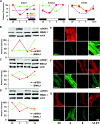Circadian clock and output genes are rhythmically expressed in extratesticular ducts and accessory organs of mice
- PMID: 18945877
- PMCID: PMC2630781
- DOI: 10.1096/fj.08-113191
Circadian clock and output genes are rhythmically expressed in extratesticular ducts and accessory organs of mice
Abstract
Circadian clocks regulate multiple rhythms in mammalian tissues. In most organs core clock gene expression is oscillatory, with negative components Per and Cry peaking in antiphase to Bmal1. A notable exception is the testis, where clock genes seem nonrhythmic. Earlier mammalian studies, however, did not examine clock expression patterns in accessory ductal tissue required for sperm maturation and transport. Previous studies in insects demonstrated control of sperm maturation in vas deferens by a local circadian system. Sperm ducts express clock genes and display circadian pH changes controlled by vacuolar-type H(+)-ATPase and carbonic anhydrase (CA-II). It is unknown whether sperm-processing rhythms are conserved beyond insects. To address this question in mice housed in a light-dark environment, we examined temporal patterns of mPer1 and Bmal1 gene expression and protein abundance in epididymis, vas deferens, seminal vesicles, and prostate. Results demonstrate variable tissue-specific patterns of expression of the two genes, with variations in levels of clock proteins and their nucleo-cytoplasmic cycling observed among examined tissues. Strikingly, mPer1 and Bmal1 mRNA and proteins oscillate in antiphase in the prostate, with similar peak-trough patterns as observed in the suprachiasmatic nuclei, the brain's central clock. Genes encoding CA and a V-ATPase subunit, which are rhythmically expressed in sperm ducts of moths, are also rhythmic in some segments of murine sperm ducts. Our data suggest that some sperm duct segments may contain peripheral circadian systems whereas others may express clock genes in a pleiotropic manner.
Figures





References
-
- Davidson A J, Yamazaki S, Menaker M. SCN: ringmaster of the circadian circus or conductor of the circadian orchestra? Novartis Found Symp. 2003;253:110–121. discussion 121–125, 281–284. - PubMed
-
- Boden M J, Kennaway D J. Circadian rhythms and reproduction. Reproduction. 2006;132:379–392. - PubMed
-
- Alvarez J D, Chen D, Storer E, Sehgal A. Non-cyclic and developmental stage-specific expression of circadian clock proteins during murine spermatogenesis. Biol Reprod. 2003;69:81–91. - PubMed
-
- Bittman E L, Doherty L, Huang L, Paroskie A. Period gene expression in mouse endocrine tissues. Am J Physiol. 2003;285:R561–R569. - PubMed
Publication types
MeSH terms
Substances
Grants and funding
LinkOut - more resources
Full Text Sources
Molecular Biology Databases

